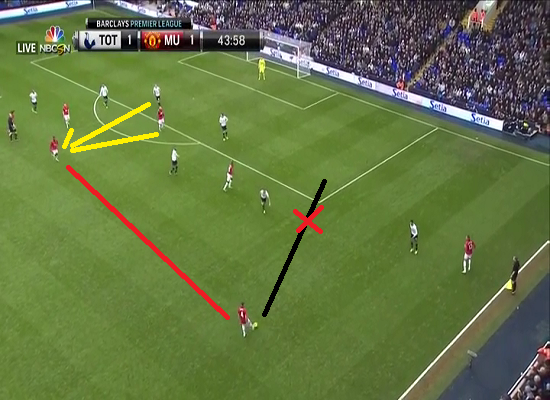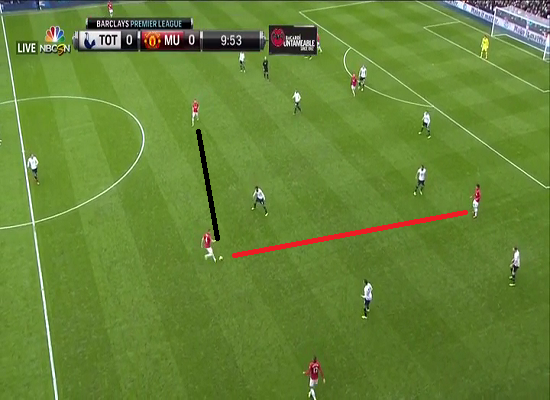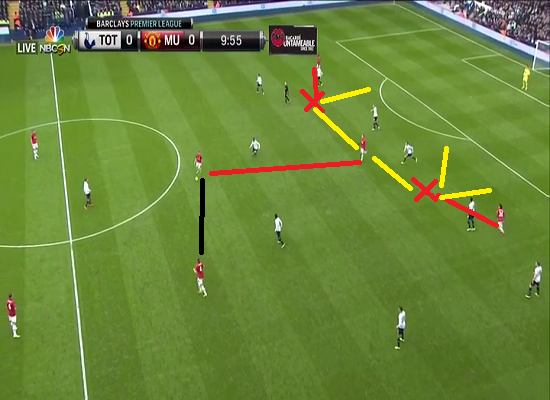
This situation highlights the concept of players seeing the pass but not having the confidence to execute it (in this case Vidic).
Welbeck is in a decent position to receive the ball. In the sequence of play, he is actually jogging backwards so for this situation to work he would need to remain stationary (where he is now). If he does receive the ball from Vidic, he has a few options available to him:
1. Lay ball off to Cleverley who can either lay off the ball to Rooney, Kagawa out wide or play the return ball to Welbeck.
2.Try to beat Chiriches on the dribble (who will be drawn to Welbeck when he receives the ball)
3. Play pass to Jones and create wide overload with Valencia
Vidic instead plays a long ball to Valencia and United's attack eventually peters out.

In this situation Rooney is passing back to Vidic as he is under pressure. Although United have maintained possession, with play being recycled through Vidic, Spurs have more time to reorganize their defensive shape. The Paulinho, Sandro, Dembele trio made it difficult for United to have any joy in midfield. United then reacted by attacking via the flanks (mainly down Valencia's side). In order to play through midfield, United needed to play quick passing interchanges.
The above picture shows a possible scenario of how to accomplish this. Instead of passing back to Vidic, Rooney would pass to Cleverley (red line) who would either pass to Jones or fill the gap left by Sandro and dribble towards Spurs' backline. If the ball goes to Jones, Jones knows he can't take on Spurs' backline by himself so he would pass back to Cleverley who would pass to Kagawa on the flank. In this picture, Evra starts his run from midfield. If he continues along the yellow line (with Kagawa on the ball), Walker will be forced to track his run which gives Kagawa the option of attempting to play him in behind or attacking the space left by Walker.

This above picture is another great example of our CMs' focus on creating via the wide areas. The black line indicates the pass Jones made in this situation. The red "X" indicates that this pass was intercepted. Welbeck checks his run towards Jones which gives Jones another passing option (red line). Let's say Jones decides to pass to Welbeck. Welbeck would then have a few options to choose from:
1. Play a first-time pass to Rooney
2. Turn, dribble and attempt a shot on goal
3.Lay the ball off to Cleverley
Based on the picture, option 1 looks the best as at this point in time, Spurs CBs are not tight on Rooney. This would give Rooney about an extra second to adjust his position and open up his body for Welbeck's first-time pass. Jones' pass to Welbeck would need to be firm otherwise, Dawson & Chiriches would have enough time to recover the situation.

Here, Jones has received the pass from Hernandez and is going to pass to Smalling to switch the play (black line). This is another area where United need to improve because while switching play is useful, if it becomes your default option, then other avenues of attack will not be used.
Notice how Spurs' CMs are all focused on Jones. If Jones played a first-time pass to Cleverley instead of opening his body up to pass to Smalling, Spurs would be caught out. Hernandez's tendency is to play the ball and then sprint into the box. While this is happening, Rooney would drop slightly closer to Cleverley's position (who now has the ball in this hypothetical situation), collect the ball from Cleverley, turn and either attempt to play Hernandez through, wait for Cleverley's support run or attempt a shot on goal.

Young takes up an okay position between Sandro and Townsend. Ideally, he would be further away from Townsend and a bit higher(closer to Spurs' backline) than where he is now. Nonetheless, Cleverley has an alternate passing option in Rooney but since it's a more difficult pass, chooses to pass to Evra on the flanks. This was an opportunity late in the game to deviate from the game plan and try and ask a different question of the Spurs' defense. Rooney is in a good position to either play Hernandez through, lay off the ball to Young who would be making a run towards goal, or take a shot on himself.
When United don't get time and space in central zones, possession is circulated in wide areas in hope that the fullbacks or wingers can penetrate the opposition. By not being more adventurous through the middle, United's pattern of play therefore becomes predictable and makes it easier for the opponent to cut out crosses or balls into the box. This is what occurred against Spurs and even though Valencia threatened multiple times throughout the game, his end product was not up to par which provided the other attacking players with very little service.
David Moyes can choose to continue with the same tactics but it's paramount that United find a reliable shuttler willing to join the attack and probe the opposition through central areas. Being able to attack through the center, does provide options to be more penetrative down the flanks. As will be shown in part 2, Giggs' adventurous play can solve part of this issue.
Thanks for reading! 











